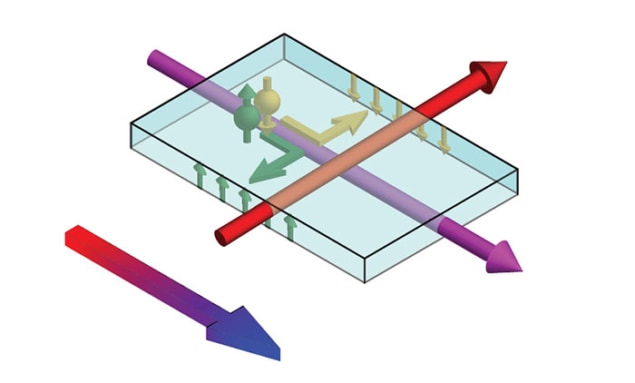
In this diagram the upper-left end of the platinum film (shown in light blue) is hotter than the lower-right end. This causes electrons to flow from hot to cold. The spin Nernst effect is shown as spin-down electrons (yellow arrows) and spin-up electrons (green arrows) moving to opposite edges of the film. (Courtesy: S Meyer et al / Nature Materials)
Sharp turn: how the spin Nernst effect works
Spin separation caused by the thermal flow of electrons has been observed by an international team of physicists. Called the “spin Nernst effect”, the phenomenon involves the separation of spin-up and spin-down electrons without the application of a magnetic field. The research could help with the development of new technologies including spintronics – circuits that store and process information using spins – and devices that convert heat into usable electrical energy.
The spin Nernst effect is the thermal version of the spin Hall effect, which occurs when electrical currents flow through thin strips made of certain materials. Spin-up electrons will migrate towards one edge of the strip and spin-down electrons towards the opposite edge of the strip. This is the result of the spin–orbit interaction between the intrinsic spin of the electron and the magnetic field created by its motion relative to the ions that make up the material.
Hard to measure
A temperature gradient along the length of a material can also drive the flow of electrons – and under the right conditions this should result in a similar separation of spins. However, the spin Nernst effect has proven difficult to differentiate from other thermal effects in a material.
Now Sebastian Gönnenwein at the Technical University of Munich and colleagues in Germany, the Netherlands and Japan have observed the spin Nernst effect in a thin strip of platinum.
Their platinum strip was about 3 mm long, 250 μm wide and 4 nm thick. The strip was created on a thicker piece of yttrium iron garnet (YIG), which is a ferromagnetic material. One end of the strip was heated to create an 18 K temperature gradient along the length of the strip. This created an electrical voltage of about 66 μV along the strip, causing an electron current to flow.
Controlling interface
The challenge for Goennenwein and colleagues was how to isolate the spin accumulation associated with the spin Nernst effect from the other thermoelectric effects that occur in their sample. Their solution involves varying the magnetization of the YIG so that under certain configurations, spins can flow across the interface with the platinum. Under other configurations, however, the flow of spins is much lower. This allowed them to observe the effect of the spin Nernst effect on the electrical currents that flow in the platinum film and confirm that the effect was occurring in their sample.
The research is described in Nature Materials.



